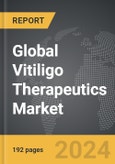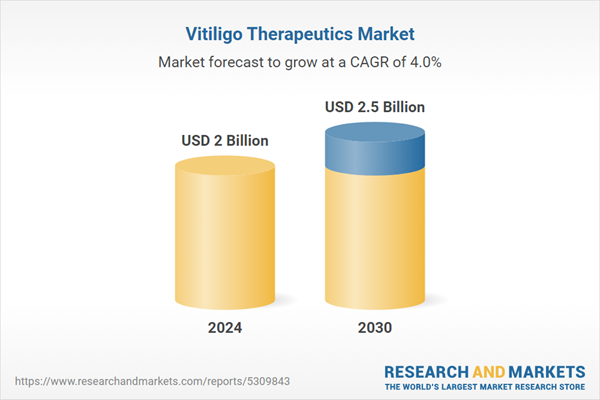The global market for Vitiligo Therapeutics was valued at US$2.0 Billion in 2024 and is projected to reach US$2.5 Billion by 2030, growing at a CAGR of 4.0% from 2024 to 2030. This comprehensive report provides an in-depth analysis of market trends, drivers, and forecasts, helping you make informed business decisions. The report includes the most recent global tariff developments and how they impact the Vitiligo Therapeutics market.
Segments: Segment (Topical, Oral, Other Segments).
Geographic Regions/Countries: World; United States; Canada; Japan; China; Europe (France; Germany; Italy; United Kingdom; and Rest of Europe); Asia-Pacific; Rest of World.
The analysts continuously track trade developments worldwide, drawing insights from leading global economists and over 200 industry and policy institutions, including think tanks, trade organizations, and national economic advisory bodies. This intelligence is integrated into forecasting models to provide timely, data-driven analysis of emerging risks and opportunities.
Global Vitiligo Therapeutics Market - Key Trends & Drivers Summarized
How Is the Vitiligo Therapeutics Market Evolving?
The Vitiligo Therapeutics market is experiencing significant growth due to increasing awareness of skin diseases and the rising prevalence of vitiligo worldwide. Vitiligo, an autoimmune disorder characterized by depigmentation of the skin, has prompted a surge in demand for effective therapeutic options. Various treatment modalities, such as topical therapies, light-based therapies, and surgical procedures, have seen advancement. Topical corticosteroids, calcineurin inhibitors, and vitamin D analogs are commonly used treatments, with new biological drugs like JAK inhibitors also gaining momentum. Phototherapy, particularly Narrowband Ultraviolet B (NB-UVB), has become a standard treatment due to its efficacy in repigmenting skin and fewer side effects compared to traditional PUVA therapy. Surgical options, like skin grafting and melanocyte transplants, are also considered for stable vitiligo cases, indicating a diversified market portfolio.What Role Do Emerging Therapies and Technological Innovations Play?
The market is also being shaped by emerging therapies and technological innovations aimed at enhancing treatment effectiveness and patient compliance. The development of new biologics and targeted therapies that modulate immune responses, such as Janus kinase (JAK) inhibitors, represents a revolutionary shift in vitiligo management. These novel drugs, currently undergoing clinical trials, have shown promise in restoring pigmentation by blocking inflammatory pathways responsible for melanocyte destruction. In addition, the use of advanced imaging technologies for precise diagnosis and the advent of telemedicine have improved patient access to dermatologists, enabling timely interventions and personalized treatment plans. These innovations are enhancing the effectiveness and safety of vitiligo treatments, propelling market expansion by offering hope for better management of the condition.How Are Consumer Awareness and Supportive Policies Impacting Growth?
Increasing consumer awareness, driven by social media campaigns and advocacy by dermatological societies, is significantly influencing the growth of the vitiligo therapeutics market. More people are recognizing vitiligo as a medical condition requiring treatment rather than a mere cosmetic concern, leading to a higher demand for therapeutic options. Additionally, supportive healthcare policies and insurance coverage for vitiligo treatments in developed economies have reduced the financial burden on patients, facilitating access to advanced treatment options. Awareness campaigns and patient support groups are also crucial in reducing stigma, encouraging early consultation, and fostering a community-centric approach to vitiligo management. These societal shifts are collectively boosting market growth by ensuring better healthcare access and patient engagement.What Factors Are Driving the Growth in the Vitiligo Therapeutics Market?
The growth in the vitiligo therapeutics market is driven by several factors, including technological advancements in treatment options, increasing prevalence of autoimmune skin diseases, and heightened awareness about skin health. The advent of targeted therapies such as JAK inhibitors and the development of combination therapies have opened new avenues for treatment, offering higher efficacy and fewer side effects. Additionally, the growing use of phototherapy devices at home due to the convenience and advancements in technology is another major driver. Increased healthcare expenditure in developing regions, coupled with improving dermatological care infrastructure, also plays a significant role. Moreover, changing consumer attitudes towards skin conditions, emphasizing early treatment and holistic management, further propel the market forward. Finally, favorable regulatory policies and initiatives aimed at enhancing research and development in dermatological therapeutics continue to support market growth by facilitating faster drug approval processes and promoting innovation.Report Scope
The report analyzes the Vitiligo Therapeutics market, presented in terms of units. The analysis covers the key segments and geographic regions outlined below.Segments: Segment (Topical, Oral, Other Segments).
Geographic Regions/Countries: World; United States; Canada; Japan; China; Europe (France; Germany; Italy; United Kingdom; and Rest of Europe); Asia-Pacific; Rest of World.
Key Insights:
- Market Growth: Understand the significant growth trajectory of the Topical segment, which is expected to reach US$1.2 Billion by 2030 with a CAGR of a 3.7%. The Oral segment is also set to grow at 4.4% CAGR over the analysis period.
- Regional Analysis: Gain insights into the U.S. market, valued at $540.2 Million in 2024, and China, forecasted to grow at an impressive 3.8% CAGR to reach $398.7 Million by 2030. Discover growth trends in other key regions, including Japan, Canada, Germany, and the Asia-Pacific.
Why You Should Buy This Report:
- Detailed Market Analysis: Access a thorough analysis of the Global Vitiligo Therapeutics Market, covering all major geographic regions and market segments.
- Competitive Insights: Get an overview of the competitive landscape, including the market presence of major players across different geographies.
- Future Trends and Drivers: Understand the key trends and drivers shaping the future of the Global Vitiligo Therapeutics Market.
- Actionable Insights: Benefit from actionable insights that can help you identify new revenue opportunities and make strategic business decisions.
Key Questions Answered:
- How is the Global Vitiligo Therapeutics Market expected to evolve by 2030?
- What are the main drivers and restraints affecting the market?
- Which market segments will grow the most over the forecast period?
- How will market shares for different regions and segments change by 2030?
- Who are the leading players in the market, and what are their prospects?
Report Features:
- Comprehensive Market Data: Independent analysis of annual sales and market forecasts in US$ Million from 2024 to 2030.
- In-Depth Regional Analysis: Detailed insights into key markets, including the U.S., China, Japan, Canada, Europe, Asia-Pacific, Latin America, Middle East, and Africa.
- Company Profiles: Coverage of players such as AbbVie, Inc., Astellas Pharma, Inc., Avita Medical, Baxter International, Inc., Clinuvel Pharmaceuticals Ltd. and more.
- Complimentary Updates: Receive free report updates for one year to keep you informed of the latest market developments.
Some of the 38 companies featured in this Vitiligo Therapeutics market report include:
- AbbVie, Inc.
- Astellas Pharma, Inc.
- Avita Medical
- Baxter International, Inc.
- Clinuvel Pharmaceuticals Ltd.
- Incyte Corporation
- Merck & Co., Inc.
- Pfizer, Inc.
- Puneet Laboratories Private Limited
- Roivant Sciences, Inc.
Tariff Impact Analysis: Key Insights for 2025
Global tariff negotiations across 180+ countries are reshaping supply chains, costs, and competitiveness. This report reflects the latest developments as of April 2025 and incorporates forward-looking insights into the market outlook.The analysts continuously track trade developments worldwide, drawing insights from leading global economists and over 200 industry and policy institutions, including think tanks, trade organizations, and national economic advisory bodies. This intelligence is integrated into forecasting models to provide timely, data-driven analysis of emerging risks and opportunities.
What’s Included in This Edition:
- Tariff-adjusted market forecasts by region and segment
- Analysis of cost and supply chain implications by sourcing and trade exposure
- Strategic insights into geographic shifts
Buyers receive a free July 2025 update with:
- Finalized tariff impacts and new trade agreement effects
- Updated projections reflecting global sourcing and cost shifts
- Expanded country-specific coverage across the industry
Table of Contents
I. METHODOLOGYII. EXECUTIVE SUMMARY2. FOCUS ON SELECT PLAYERSIII. MARKET ANALYSISIV. COMPETITION
1. MARKET OVERVIEW
3. MARKET TRENDS & DRIVERS
4. GLOBAL MARKET PERSPECTIVE
UNITED STATES
CANADA
JAPAN
CHINA
EUROPE
FRANCE
GERMANY
ITALY
UNITED KINGDOM
REST OF EUROPE
ASIA-PACIFIC
REST OF WORLD
Companies Mentioned (Partial List)
A selection of companies mentioned in this report includes, but is not limited to:
- AbbVie, Inc.
- Astellas Pharma, Inc.
- Avita Medical
- Baxter International, Inc.
- Clinuvel Pharmaceuticals Ltd.
- Incyte Corporation
- Merck & Co., Inc.
- Pfizer, Inc.
- Puneet Laboratories Private Limited
- Roivant Sciences, Inc.
Table Information
| Report Attribute | Details |
|---|---|
| No. of Pages | 192 |
| Published | April 2025 |
| Forecast Period | 2024 - 2030 |
| Estimated Market Value ( USD | $ 2 Billion |
| Forecasted Market Value ( USD | $ 2.5 Billion |
| Compound Annual Growth Rate | 4.0% |
| Regions Covered | Global |









